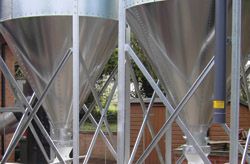Biomass offers a very effective heating solution for many schools but it's important to address the key practical issues that go with it. Andy Owens, biomass technical sales manager with Hoval, explains.
In striving to meet its carbon emissions targets, the education sector has been quick to take advantage of the benefits of biomass. Consequently, we have much experience of school biomass projects and it is clear there is a need to take account of more than just the basic engineering design. The specifier needs to evaluate the practicalities that accompany any biomass system.
The first stage is to understand the range of heat loads through the year and to design for continual load with minimum cycling. Also to be considered is the potential benefits of a suitably- sized buffer vessel and whether other heat sources - conventional or renewable - should be included.
Different biomass boilers deal with variable loads. Some may go into standby mode without going out, offering a rapid response to a call for heat. Others may go out completely and use auto-ignition to refire providing a slightly slower response.
Other issues include the overall suitability of the site in relation to fuel storage and deliveries; both of which impact on the choice of wood fuel to be used. In the UK that choice usually comes down to wood chips or wood pellets.
Wood chips show greater variation in combustion efficiency and physical size and have a lower calorific value than pellets, so for a given heating capacity they will require either higher storage volumes or more frequent deliveries.

Vertical storage silos maximise fuel recovery
Because of the volumes involved, chips are normally delivered by tipper lorry and this will determine the dimensions for access routes and turning circles. Below-ground storage will also be required to receive fuel from the tipper, along with a mechanism (e.g. push/pull floor) for moving the chips from the store to the fuel transport system. A ceiling mounted fuel dispenser can be used to spread the chips throughout the store. If a fuel dispenser is not used, multiple fuel delivery hatches will be needed for the full capacity of the store to be used.
The irregular shape and size of chips means they need more robust handling equipment with larger augers and motors, compared with pellets. In addition, the distance from storage to boiler should be as short as possible to minimise the number of augers required, the chances of fuel blockages and the cost.
On the plus side, chips cost less than pellets, though the cheapest chips will usually produce higher volumes of ash.
Pellets are usually delivered by a smaller 'blower' vehicle with less access requirements. The best results are achieved using a vertical storage silo as this maximises fuel recovery. The silo may be manufactured from glass reinforced polyester for outdoor use or a fabric silo can be assembled in-situ indoors. Because of their height, outdoor silos may require planning permission.
All biomass fuels produce particulate emissions and the volume and nature of these will vary with fuel quality, as well as combustion efficiency. Using boilers that comply with EN 303-5 Class 3, in conjunction with high quality fuel, is the first step in minimising particulate emissions but some filtration will also be necessary.
EU directive
Until recently cyclones and multi-cyclones have been the only viable option but their operation depends on particle size and they are able to remove only about 50 per cent of the particles down to a diameter of 10 microns (PM10). However, EC Directive 2008/50/EC (ambient air quality and cleaner air for Europe), which comes into force in June 2010, will require control of particles down to 2.5 microns (PM2.5).
This is a cause of concern for many local authorities but a new ceramic filter has recently entered the market that is capable of removing up to 96 per cent of PM2.5 and PM10 particles. Given the sensitivity of air quality issues, most LAs will probably require specification of this higher level of filtration in the future.
It is important to get the buy-in of the people who will use these boilers as they will need to understand how they differ from the more familiar gas or oil ranges particularly any maintenance aspects.
Furthermore, many schools have only part-time janitors so this may have a bearing on the choice of boiler and feed system. Several schools are also using their biomass plant as part of their environmental studies, so the design of the boiler should include a viewing window or similar.
For these reasons it's vital to look beyond the engineering design when specifying biomass. The building services engineer is still best placed to address these issues, working with suppliers that have specialist knowledge and experience of biomass.
For more information visit:
www.hoval.co.uk